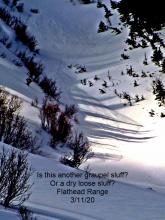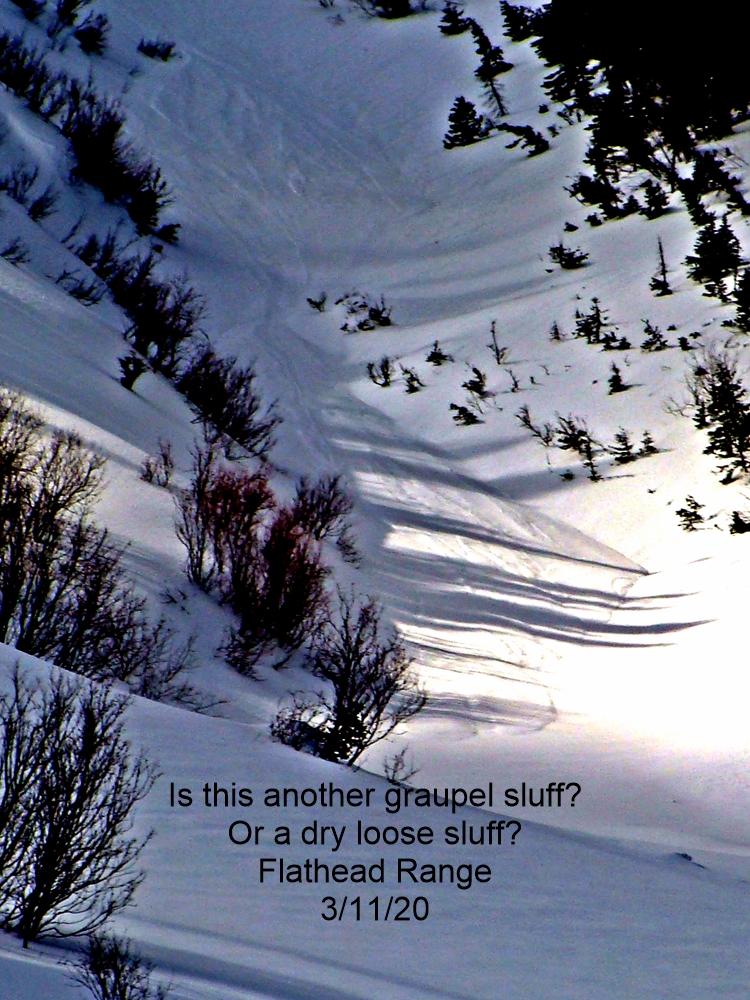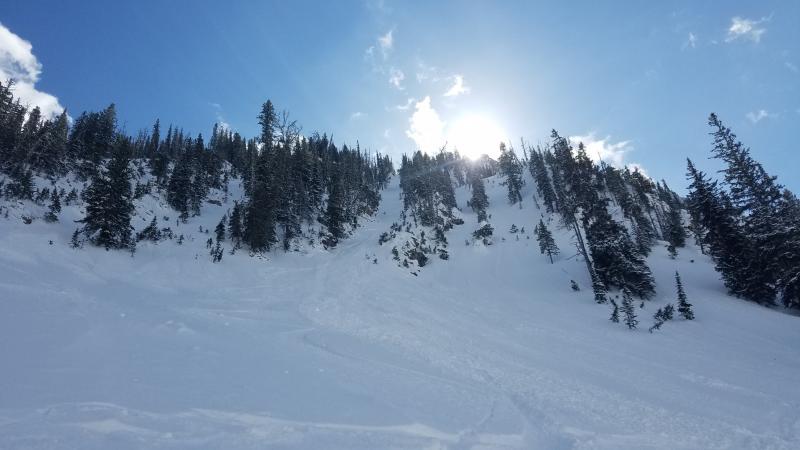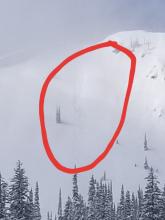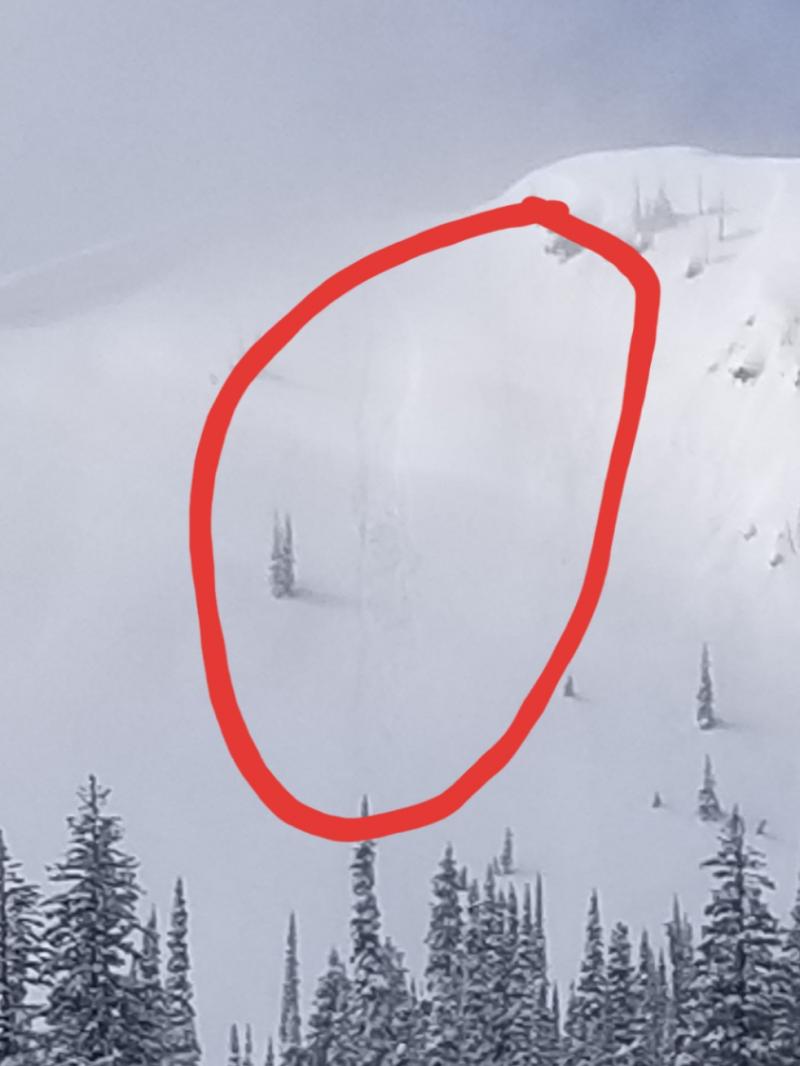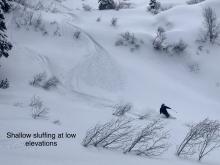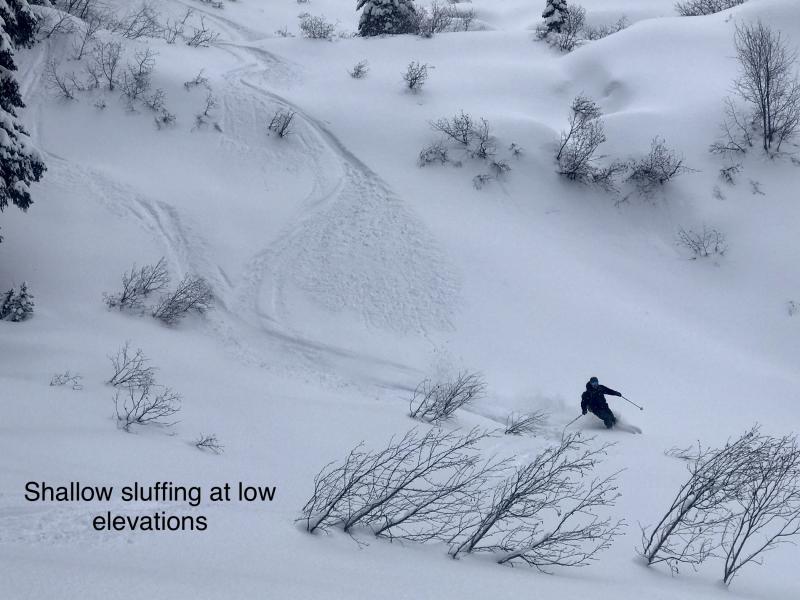| Wednesday | Wednesday Night | Thursday | |
|---|---|---|---|
| Cloud Cover: | Snow showers. | Snow showers. | Snow showers. |
| Temperatures: | 28-40 deg. F. | 15-23 deg. F. | 27-39 deg. F. |
| Wind Direction: | W | W | N-NE |
| Wind Speed: | 9-14 gusts 21-32 | 6 | 8-9 gusts 20 Flathead Range |
| Snowfall: | 1-3 in. | 2-4 in. | 1-3 in. |
| Snow Line: |
Whitefish Range
Swan Range
Flathead Range and Glacier National Park
How to read the forecast
Fresh wind slabs continue to form throughout the upper elevations of our area. These slabs will be sensitive to the weight of a skier or rider and you are likely to trigger a wind slab avalanche in steep open terrain today. Continue to assess windloaded areas before committing to a slope. The avalanche danger is CONSIDERABLE on steep wind loaded terrain above 6000 feet. Between 5000 and 6000 feet the danger is MODERATE.

3. Considerable
?
Above 6500 ft.
2. Moderate
?
5000-6500 ft.
1. Low
?
3500-5000 ft.
- 1. Low
- 2. Moderate
- 3. Considerable
- 4. High
- 5. Extreme
-
Type ?
-
Aspect/Elevation ?

-
Likelihood ?CertainVery LikelyLikelyPossible
 Unlikely
Unlikely -
Size ?HistoricVery LargeLargeSmall

We observed up to 16 inches of low density snow that has fallen since Saturday's rain event. Yesterday, in the southern Whitefish Range, we noticed that this snow has been transported and drifted into wind pillows. With light to moderate winds and low density snow to transport, fresh wind slabs formed overnight and will continue to be formed at upper elevations today. In some areas wind slabs were deposited on crusts that will provide a smooth surface to slide on. Look for smooth, rounded features on the snow surface along leeward ridgelines. Carefully evaluate wind-loaded terrain before skiing or riding on a slope. Due to a lack of observations there is a bit of uncertainty that exists with wind slab development and distribution.
-
Type ?
-
Aspect/Elevation ?
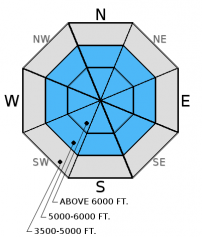
-
Likelihood ?CertainVery LikelyLikelyPossible
 Unlikely
Unlikely -
Size ?HistoricVery LargeLargeSmall

Yesterday, in the southern Whitefish Range, we found buried surface hoar 3 feet from the snow surface in 2 different locations. In one pit the surface hoar was large grain and propagated with hard force in stablity tests. In the other pit this layer was decomposing and was not reactive in stability tests. This layer was formed in late February and seems to be most prevalent in the Whitefish Range, but we believe that it exists in other ranges as well. Yesterday's results prove that it remains important to dig into the snow and look for it before skiing or riding on a slope. In other recent observations from the Flathead Range skiers noted weak, faceted snow around more recent crusts in the upper snowpack that proved reactive in stability tests. Keep in mind that while we have not put a large rapid load on these layers the incremental snowfall will add stress and may cause them to become more reactive.
-
Type ?
-
Aspect/Elevation ?

-
Likelihood ?CertainVery LikelyLikelyPossible
 Unlikely
Unlikely -
Size ?HistoricVery LargeLargeSmall

The low density new snow that we have received over the past few days has been deposited onto a rain crust in many locations. This new snow is not bonding well to the crust and is sluffing easily on steep terrain. On Tuesday, in the southern Whitefish Range, we were able to initiate loose snow avalanches in the 16 inches of new snow which then traveled long distances and entrained a fair amount of snow.
The combination of relatively cold dry surface snow and the strong mid March sun will create a wet loose avalanche problem if we have breaks in the clouds today. Yesterday, we noticed that it only took a few minutes of solar warming to initiate rollerball/pinwheel activity on steep sunny aspects. This is an easy problem to manage and just requires you to move to a more shaded aspect as the surface snow becomes moist.
Both wet and dry loose avalanches will be relatively small but can surprise you, knock you off your feet and ruin your day.
Additional Concerns: Also, as we approach spring and daily maximum temperatures rise above freezing on a more regular basis, cornices will likely become more sensitive and glide cracks could begin to fail. Cornices can trigger slab avalanches on the slopes below making the consequences more severe. Give cornices a wide berth while traveling along ridges and limit your exposure time when traveling below them.
Tuesday: My partner and I toured east of the WMR ski area boundary in the southern Whitefish Range where we found 16 inches of low density snow sitting on top of the rain crust that was formed Saturday. This snow sluffed easily and traveled long distances on steep north facing terrain. We found a layer of decomposing surface hoar 3 feet below the surface that was unreactive in stability tests. There was substantial evidence of recent wind transport (observation). Erich was just west of the ski area and found large grain surface hoar 3 feet below the surface that propagated in his ECT tests with hard force. Both parties found an impressive layer of graupel that was 8 inches below the surface which was adding to the new snow instability.
Monday: I travelled to the Marion Lake area of the Flathead Range. Above 6200 feet I found 4-6 inches of new snow sitting atop a rain crust. This new snow was not bonding well with the crust and was sluffing during our ski descent. We were unable to locate buried surface hoar but we did find evidence of recent and current wind loading (observation). Skiers in the southern Whitefish Range had propagation in their stability tests on a layer of facets atop a melt freeze crust 90 cm from the surface (observation)
Sunday: Skiers in the Tranquil Basin/Mt. Furlong area in the Flathead Range found a breakable crust below 5500 feet. At upper elevations they noted multiple crusts within the top 16 inches of the snowpack with weak, facets between them. Their stability tests produced fractures with propagation in this weak snow using hard force (observation).
Saturday: Todd and I rode up to Hash Mountain in the Swan Range. On the ride through the Lost Johnny drainage we observed 2 small, recent slab avalanches (observation). The rain transitioned to wet, heavy snow at about 6000 feet. We found 3-5 cm of new snow on top of the most recent crust and noted lots of roller ball activity in the new snow (observation). Guy was on Paola Ridge in the Flathead Range. He found small, decomposing surface hoar buried 14 inches from the surface. This layer fractured with easy force in compression tests (observation).
Thursday: Erich and Todd traveled along a safe ridge outside the ski area boundary yesterday and remotely triggered a small storm slab avalanche from the ridge (observation 1) and observed widespread shooting cracks and a collapse (observation 2). They also found buried surface hoar 1.5 to 2 feet from the surface to fracture and propagate in our stability test with moderate force (video). Whitefish Mountain Resort Ski Patrol also reported very reactive storm and wind slabs during their avalanche mitigation work Thursday morning (observation).
Wednesday: Erich traveled to Red Meadow Peak in the northern Whitefish Range where we found up to 5 inches of low density snow sitting atop a firm rain crust all the way to 7500 feet. He also found buried surface hoar up to 2 feet from the surface that fractured and propagated in stability tests (observation, video). He noted wet, loose avalanche debris from the weekend, but no new avalanche activity.
Visit our Observations page and our You Tube channel for more observations from the entire season.
Thanks to everyone for submitting observations. They are extremely useful and could help save lives.
HOW TO SUBMIT OBSERVATIONS:
Email: [email protected]
Call and leave a message: 406.387.3821
You can also submit quick observations via text: 406.241.4571 (FAC mobile)
OR
Submit Snowpack Observations: http://www.flatheadavalanche.org/node/add/snowobs
Submit Avalanche Observations: http://www.flatheadavalanche.org/node/add/avyobs
1-5 inches of new snow fell over the past 24 hours. Since Sunday night, 0.6 to 1.3 inches of snow water equivalent (SWE) and up to 16 inches of snow has fallen across the advisory area. Currently, temperatures above 6000 feet range from 16º-25º F, and winds are out of the southwest at 4-16 mph with gusts from 12-23 mph. Today should bring more snow showers with up to 4 inches forecast for the Swan Range.. Temperatures are expected to rise to the upper-20s to low-30s, and winds will continue out of the southwest at 10-20 mph with gusts in the mid 20s to low 30s. More snow is expected tonight into tomorrow.
| 0600 temperature: | 17-25 deg. F. |
| Max. temperature in the last 24 hours: | 20-30 deg. F. |
| Average wind direction during the last 24 hours: | SW |
| Average wind speed during the last 24 hours: | 10-20 mph |
| Maximum wind gust in the last 24 hours: | 22-37 mph |
| New snowfall in the last 24 hours: | 1-5 inches |
| Total snow depth: | 87-111 inches |
This advisory applies only to backcountry areas outside established ski area boundaries. This advisory describes general avalanche conditions and local variations always occur. This advisory expires at midnight on the posted day unless otherwise noted. The information in this advisory is provided by the USDA Forest Service who is solely responsible for its content.

























